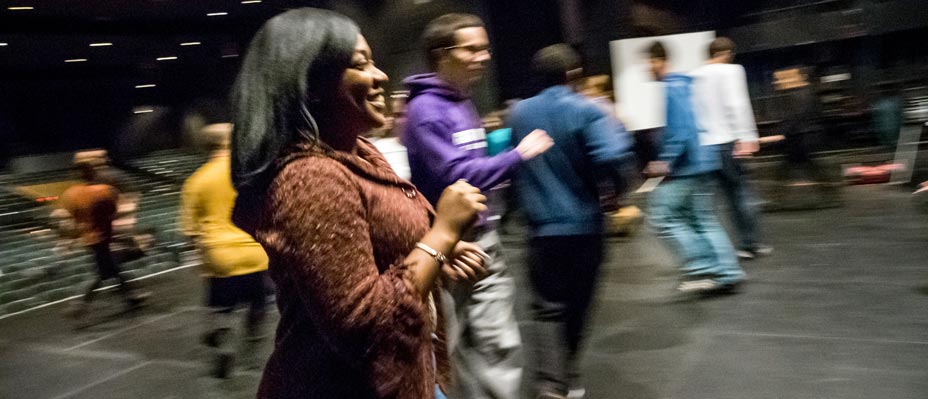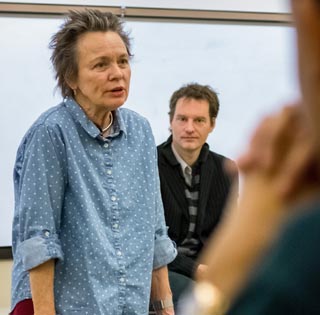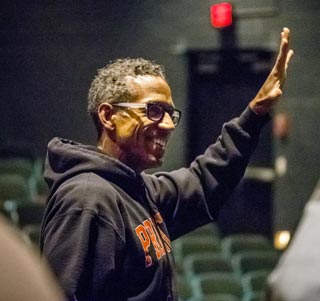Cultivating Creativity
Innovative course explores creative thinking across disciplines
What inspires creativity? Using quotes from Miguel Cervantes and Walt Whitman, Michael Lees, a philosophy and religion professor, prompts students in the University’s popular Creative Thinking course to jump-start their imaginations by establishing a relationship with a tree and recording their reflections in a journal. “I believe we all participate in a creative process in this life,” he says.
With its colorful and deeply introspective results, Lees says, the journal is an effective tool in a course that encourages students to tap their innermost thoughts, ideas and feelings.
The course was developed in part to counter a national “creativity crisis,” first identified in a 2010 landmark study that tracked a persistent 20-year decline in test scores measuring children’s creativity. Since 2012 the course has tackled that crisis head-on by exploring the creative process in diverse disciplines from dance and math to physics and philosophy.

Students participate in a movement workshop as part of the University's course in creative thinking.
A new way of thinking
A cross-disciplinary team of professors launched the course, a collaborative venture of the University’s Office of Arts and Cultural Programming, the Research Academy for University Learning and the Peak Performances series, with the support of a Creative Campus Innovations grant from the Association of Performing Arts Presenters and funding from the Doris Duke Charitable Foundation.
Ashuwin Vaidya, a physics professor who led classes in both the 2012 and 2014 summer sessions, helped develop the curriculum, making sure that visits from Peak Performances artists are an integral part of it. The course committee was also inspired by a groundbreaking curriculum developed in the 1950s by artist and educator Paul Baker. “The seed for our course was sown at some level by his thinking,” says Vaidya.
“This course disrupts the notion that creativity is a mysterious attribute that ‘strikes’ like a bolt of lightning or stroke of genius.”
- Carrie Urbanic
Carrie Urbanic, Arts and Cultural Programming’s cultural engagement director, along with Executive Director Jedediah Wheeler, has been involved from the start and stresses that the goal is to expand knowledge of the creative process.
“This course disrupts the notion that creativity is a mysterious attribute that ‘strikes’ like a bolt of lightning or stroke of genius,” Urbanic says.
The course title grabbed senior psychology major Samantha Cardona’s attention. “I’ve learned to stop limiting myself and apply what I’ve learned to my everyday life,” she says. “The professors did an awesome job creating an environment where there was room for debate – without judgment.”
Research Academy for University Learning Assistant Director Julie Dalley facilitates faculty development for the course and also occasionally leads classes in creative writing exercises. “The course lets students explore ideas that traditional courses rarely allow,” she explains. “It guides them in breaking down mind-sets that may prevent them from taking risks. It also allows faculty to take risks and experiment with ideas with their students.”

Visiting performance artist and musician Laurie Anderson shared her thoughts on creativity with classes in 2013.
Creativity Starts Here
Vaidya views himself as a guide, facilitator and student in the course. “I want students to think and question on their own,” he says.
This past summer, one of the faculty members joining Vaidya in the classroom was mathematics professor Mika Munakata, who asked students to find connections to science and math in a dance performed on campus in 2011 by the Brazilian troupe, Companhia Urbana de Dança. “I tried to broaden the students’ understanding of what doing math is,” she says.
“The course opens students’ eyes to new ways of understanding the learning process,” Munakata says. “It lets faculty step outside what we typically teach and challenges us to think about the role of creativity in our disciplines.”
For Kirk McDermid, a philosophy professor, the greatest benefit of the course is its focus on exploration. “Exploring is risky, full of failure and hard to quantify,” he says. “But when successful, it yields tremendous rewards.”
Grammy-nominated singer-songwriter Liz Queler visited and shared performance insights with students. In June, she and her husband, Seth Farber, performed Still Will Be Heard on campus. Produced by Peak Performances, the piece set 17 poems by Edna St. Vincent Millay to a mix of rock, folk, jazz and bluegrass music.
Students attended the rehearsal and the world premiere before Queler and Farber visited the class. Queler joins a roster of distinguished artists, including musician and performance artist Laurie Anderson, choreographer Liz Lerman and director Robert Wilson, who have also shared their thoughts on creativity with students.

Choreographer and director David Roussève led a movement workshop this summer.
A new perspective
Christopher Parker, a classics and general humanities professor, focuses his section of the summer course on building creative thinking with metaphoric language. “Creative thinking is awareness of your ability to trust your tacit understandings –which some call inspiration,” he says.
The instructors agree that creativity is difficult to define. “You know when you are in its presence and in that zone,” Vaidya says. “In this course we try to find that zone and replicate it.”
After taking the course, sophomore Annalyce D’Agostino says she is ready to take on anything. “My biggest takeaway from the course was my ability to look at the world anew,” she says.
“I learned to look at an object as simple as a tree through the lens of language, mathematics, dance, religion, philosophy and science,” says D’Agostino. “While examining a tree, a classmate and I noticed the ridges of bark, the shapes of the individual leaves. The seeds blew away from the branches, resembling snowflakes. That right there is life.”
That’s exactly what instructors hope students will remember.
